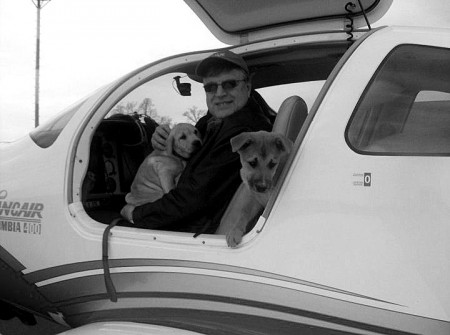
Michael Young with two rescued dogs he transported from southern kill shelters. Photo courtesy of Michael Young
In addition to his duties as an adjunct professor and advisor to the aviation club at George Mason University, Michael Young has devoted his time to saving dogs since being introduced to Pilots N Paws, a website dedicated to the rescue, shelter and fostering of animals.
Pilots N Paws works to connect pilots to organizations that rescue dogs from high-kill shelters in southern states and helps them find adoptive families in the north. The responsibility, in both time and energy, falls upon the pilot to transport the dogs from the southern states to the north.
According to Young shelter dogs in the south outnumber adoptive couples. But in the north there are fewer dogs, so it is easier for organizations to find people willing to adopt.
“What people have done is go to these high-kill shelters and pull the dogs from these shelters in these rural parts of the southeast and they have relationships with receiving rescues in the northeast and they move the dogs up there,” Young said.
Young participates in a relay system in which another pilot might transport the rescued canines from North Carolina to Virginia, whereupon Young would then finish the journey by flying the dogs to their destination somewhere in the north, such as Pennsylvania.
The majority of the dogs are driven by truck, but then they are put in crates and the experience can be rough for the dog, so planes are also used in the process. “I generally don’t use crates,” Young said. “I let the dogs roam around. They sit on people’s laps. They sleep. It’s not a stressful thing at all.” The downside to air transportation is that pilots generally move only five to 10 dogs at a time.
Many area pilots are unaware of the program. “They don’t know about it. How would they know about it?” Young said.
Participating in these rescue flights is not cheap and carries costs for the pilots. “Flying these general aviation airplanes is not inexpensive,” Young said. Depending on plane size and speed, it can cost anywhere from $1.05 to $1.40 for each mile flown. On a typical 500-mile flight, a pilot would have to pay roughly $500 in expenses.
Despite the price tag and difficulties associated with the charity work, Young enjoys what he does. “What else am I going to do with my life?” Young said. “If you really love dogs — and I love my two dogs — the love for my dogs extends to all these other dogs. I look in their eyes, and they’re just amazing creatures. They’re just wonderful creatures. … I can give other people the joy of having these dogs.”






Comments